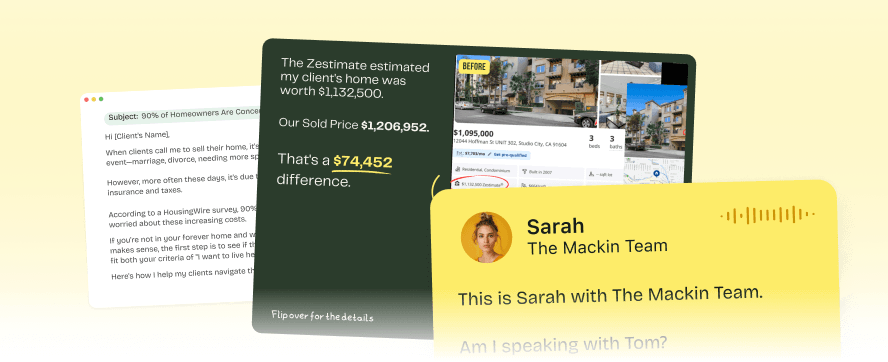
Real Estate GCI: How to Calculate Commission & Splits
Gross Commission Income (GCI) is the total commission revenue from closed sales before splits, referral fees, expenses, or taxes. It’s the top-line production number agents and brokerages use to measure performance.
Gross Commission Income (GCI) is the total commission revenue from closed sales before splits, referral fees, expenses, or taxes. It’s the top-line production number agents and brokerages use to measure performance.
What Is GCI in Real Estate?
GCI is the top-line revenue number every agent tracks. It’s the total commission dollars you generate from closed transactions before any deductions. Think of GCI as your production scorecard. It’s the number coaches, brokerages, and teams look at to measure growth and set yearly goals. Your actual check (sometimes called Net Commission Income) comes after your brokerage split, fees, and expenses—but GCI is the clean, universal way to compare production across agents.
Example:
- Sale price: $400,000
- Side commission: 3%
- GCI = $400,000 × 0.03 = $12,000
That $12,000 is your gross commission income. What you take home depends on your split and costs, but the GCI is what gets reported as your production.
GCI vs. Net Commission Income (NCI)
It’s easy to confuse Gross Commission Income (GCI) with what actually lands in your bank account. They’re related—but not the same.
- GCI (gross): the full commission you generate from a transaction before any deductions.
- NCI (net): what you actually keep after your brokerage split, referral fees, transaction fees, marketing costs, and taxes.
Why it matters: Agents often set their yearly goals in GCI because it’s the industry standard for tracking production. But when you’re building a budget—or figuring out how many closings you need to hit your personal income target—you need to work off net.
Example: $500,000 sale at 3% side commission
- GCI: $500,000 × 0.03 = $15,000
Now apply deductions:
In this case, your GCI was $15,000, but your Net Commission Income (take-home) was closer to $5,600.
How to Calculate GCI in Real Estate
The math itself is simple:
GCI = Sale Price × Commission Rate (your side)
If you represent both sides of a deal, you add both commissions. If there’s a referral fee, that comes off the top before your broker split (in most cases — check your ICA).
Example 1: Listing side only
- Home sells for $500,000
- Listing side commission: 2.5%
- GCI = $500,000 × 0.025 = $12,500
Example 2: Buyer side only
- Home sells for $500,000
- Buyer side commission: 3%
- GCI = $500,000 × 0.03 = $15,000
Example 3: Double-sided transaction
- Same $500,000 sale
- You represent both buyer and seller
- Commission: 2.5% listing side + 3% buyer side = 5.5%
- GCI = $500,000 × 0.055 = $27,500
Example 4: Referral involved
- $500,000 sale at 3% buyer side commission
- Gross commission: $15,000
- 25% referral fee owed to referring agent: $3,750
- Adjusted GCI = $15,000 – $3,750 = $11,250
(Referral fees are almost always calculated before broker splits — confirm your brokerage’s policy.)
Example 5: Brokerage cap scenario
- $500,000 sale at 3% = $15,000 GCI
- Your brokerage cap is $16,000 in company dollar
- If you’ve already hit the cap this year, you keep nearly 100% of that $15,000 (minus small transaction/tech fees)
- If you’re still $2,000 short of cap, then $2,000 goes to the brokerage and you net $13,000 before expenses
Example 6: $300,000 sale, buyer side at 3%
- $300,000 × 0.03 = $9,000 GCI
- On 70/30 split → $6,300 before expenses
Pro Tip: Always track your GCI year-to-date, not just per transaction. That’s how you’ll know when caps reset, when higher splits kick in, and how many more closings you need to hit your annual income goal.
From GCI to Your Check (Splits, Caps, and Fees)
Knowing your GCI is the first step. But what really matters is how much of that number actually makes it to your account after splits, caps, and fees.
Broker Split Examples (on a $15,000 GCI)
(These are before transaction fees, marketing expenses, or taxes. Your ICA may vary.)
Cap Example: Why Tracking YTD Matters
If your brokerage has a $16,000 cap, you’ll keep paying splits until you’ve contributed $16k in “company dollar.” After that, you usually go to near-100% for the rest of your anniversary year (minus small per-deal or tech fees).
- In the table above, a 70/30 split pays the broker $4,500.
- If you’ve already paid in $13,000 YTD, this deal would put you over cap. The next closing would be nearly 100% yours.
Tracking year-to-date company dollar is how you know when your checks are about to jump.
Team Splits & Referral Fees
Most agents on teams also split with their team lead. A common sequence looks like this:
- Referral fee (if any) comes off the top.
- Apply broker split (or cap).
- Apply team split (often 50/50 or 60/40).
- Subtract transaction or marketing fees.
Always confirm the order in your Independent Contractor Agreement (ICA). Even a small change in order can shift your take-home by thousands over a year.
Goal-Setting With GCI
Once you understand what GCI is and how it flows through splits and fees, the next step is using it for planning. GCI is the industry standard for production goals because it’s simple to track. The trick is to reverse-engineer how many closings you need to hit your target.
The Formula
Closings Needed = Target GCI ÷ (Average Sale Price × Average Side Commission Rate)
Example 1: $100,000 GCI Goal
- Avg sale price: $500,000
- Avg side commission: 2.5%
- GCI per deal = $500,000 × 0.025 = $12,500
- Closings needed = $100,000 ÷ $12,500 = 8 closings
Example 2: $250,000 GCI Goal
- Same assumptions
- Closings needed = $250,000 ÷ $12,500 = 20 closings
Example 3: $500,000 GCI Goal
- Closings needed = $500,000 ÷ $12,500 = 40 closings
Quick Reference Table
Pro Tips for Goal-Setting
- Work backwards from net. If you want $150k in net take-home and you’re on an 80/20 split with $20k in yearly expenses, you’ll need roughly $212k in GCI.
- Track YTD GCI. This helps you know when you’re on pace—or when you need to adjust your pipeline.
- Use realistic averages. Base your math on the price point and commission rate you actually work, not just market averages.
Why GCI Matters (and Common Mistakes to Avoid)
Think of GCI as your “gross paycheck” before deductions. It’s simple, universal, and the number every brokerage, coach, and MLS stat sheet recognizes.
Why it matters:
- It’s the industry’s production scorecard. Brokerages, coaches, and teams all measure agent performance in GCI.
- It helps with goal-setting. You can quickly see if your pipeline supports your income target.
- It’s simple. Volume can be misleading, but GCI ties directly to the money side of your business.
Common mistakes agents make:
- Mixing GCI with net income. GCI is gross; your net is what hits your account after splits, fees, and taxes.
- Ignoring referrals. Referral fees usually come off the top before splits—forgetting this makes your math look better than reality.
- Double-counting both sides. Only use your side’s commission unless you truly double-end the deal.
- Budgeting off GCI. Always plan expenses and personal budget from net, not gross.
- Not tracking year-to-date. Knowing where you stand against your cap or annual goal helps avoid surprises.
FAQ: GCI in Real Estate
What does GCI mean in real estate?
Gross Commission Income (GCI) is the full commission earned from a closed sale before anything gets deducted - no broker split, no referral cut, no transaction fees, and no taxes.
How do you calculate GCI?
Take the sale price of the property and multiply it by your side’s commission rate.
Example: $500,000 × 2.5% = $12,500 GCI.
What’s the difference between GCI and net income?
GCI is your gross commission number. Net is what lands in your account after the split, any referral/transaction fees, marketing costs, and taxes. GCI is before deductions. Net is your take-home.
Does GCI include broker splits?
No. GCI is always before splits. Referral fees, broker split, and team split all come afterward. In most agreements the order is: referral off the top → broker split → team split → transaction/marketing fees.
Why is GCI important for real estate agents?
Because it’s the cleanest way to measure production. Brokerages, teams, and coaches all use GCI as the benchmark. Tracking it helps you know if your pipeline is big enough, when you’ll hit your cap, and how many closings you need to reach your income target.
What is a good GCI for an agent?
In many markets, new agents aim for ~$100k GCI their first year, while mid-career agents often set targets of $250k–$500k+. Top producers in high-price markets regularly exceed $1M+ GCI. The key is to reverse-engineer: Net goal ÷ split ÷ average deal size = your GCI target.

You’re about to make a really smart decision.
ListingLeads.com is your go-to source for all the marketing and sales campaigns you need to attract more listings. Join more than 3,000 agents and get instant access to 285+ proven listing attraction campaigns.

